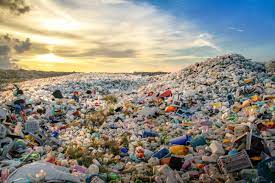
Electronics that have either reached the conclusion of their useful lives or have become worthless to their present owners are referred to as “e-waste.” E-waste may release toxins when improperly disposed of or repurposed, creating a significant environmental issue.
Concerningly, the amount of e-waste is rising, especially in poorer countries where it is exported for processing as a less expensive option, frequently leading to improper disposal techniques. A survey sponsored by the UN indicated that 53.6 million metric tons of electronic trash were discarded globally in 2019; by 2030, that number is predicted to rise to 74.7 million tons.
Over a hundred Empire State buildings’ worth of electronic garbage might be created at this rate. Only 17.4% of that particular e-waste was gathered and recycled in 2019, according to the research, which implies that 82.6% of it hadn’t been properly gathered or maintained in an ecologically beneficial way.

Defining Electronic Waste
Electronic trash, also known as WEEE, or waste from electronic and electrical devices, is typically referred to as the outcome of end-of-life electrical and electronic devices (EEE). We can define waste disposal more broadly thanks to these words.
Large domestic appliances (washing machines, dryers, and refrigerators), information technology devices (personal laptops or pcs), and electronics for consumers (cell phones as well as televisions) may typically be divided into discrete groups. E-waste can also originate from toys, medical equipment, and microwaves in addition to these categories.
E-waste recycling
When these items are thrown away or improperly recycled, the amount of e-waste rises, and when a device is thrown away, the public is typically unaware of the negative effects of the product’s life cycle. The fact that many electronic items have shorter life cycles is another significant factor contributing to the issue of e-waste.
For instance, a research study that appeared in Economics Review International found that many laptops and cell phones now have a usable life of just under two years. Consumer desires or technological developments may also be to blame for the rising volume of electronic trash.

The models of cell phones and laptops are updated more frequently, and new charger models are typically included. Therefore, as EEE’s consumer life lifetime has gotten shorter, there is more e-waste.
There are several environmental and health problems brought on by the discharge of harmful substances from e-waste, including lead, copper, manganese, as well as polybrominated diphenyl ethers (PBDEs). The connection between these circumstances and health outcomes was examined in a review article that appeared in The Lancet journal of Global Health.
People who work at e-waste disposal facilities have impaired thyroid function, and the presence of PBDEs was linked to undesirable delivery outcomes including birth weights that were low and spontaneous abortions. Children who are exposed to lead during the recycling of e-waste are more likely to experience neurocognitive problems, and the presence of zinc, manganese, and nickel also had an impact on the function of their lungs.
However, the process of disposing of e-waste exposes individuals to what are known as e-waste associated combinations (EWMs), which are extremely hazardous combinations of chemicals that are typically introduced through breathing in, contact with soil, and even the consumption of water and food that has been contaminated. These problems are typically related to direct exposure.

Because they may spread across great distances, EWMs are particularly dangerous. For instance, they can pollute aquatic ecosystems and land through air movement, have an impact on soil through runoff, and reach pools of water and land. These chemicals can contaminate food supplies and expose large areas of the environment to the environment.
Environment-Related Issues
An investigation of the potentially harmful byproducts for e-waste and the components of the electronic devices from which they came from was published within the Archives of Global Health. Flame retardants, which can seep into streams and contaminate the atmosphere, or electrostatic fluids, grease, and coolants in turbines, which bioaccumulate mainly in fish and shellfish, are examples of organic pollutants that persist (POPs) found in electronics.
These compounds, when absorbed by the atmosphere, can worsen the impact of greenhouse gases and taint food along with dust particles.
What Are Organic Persistent Pollutants?
Chemical compounds that are organic and withstand environmental deterioration are known as persistent organic pollutants (https://echa.europa.eu/understanding-pops) (POPs). They are purposefully developed for usage in many businesses.
POPs include both pesticides like DDT and chemical substances like biphenyls that are polychlorinated (PCBs), which are found in electrical equipment. The inappropriate recycling of e-waste in India was examined in a research study that appeared in Environmental Monitoring & Assessment, which identified the specific electronic components and processing steps that endanger the environment.
For instance, the study discovered how cathode ray tubes, or CRTs, which are used on televisions, can damage the environment when they break or if the yoke is removed because materials like lead and barium can seep into the groundwater and create hazardous phosphor. Desoldering and removing computer chips from printed circuit boards provide an occupational risk of breathing tin, mercury, lead, brominated dioxin, as well as arsenic.
Chips and gold-plated components are treated with hydrochloric as well as nitric acid in a chemical strip before being torched. This might result in the direct flow of hydrocarbons including brominated chemicals into waterways or bank areas.
When rain breaks down the chemicals as well as the runoff goes to these locations, e-waste also pollutes the water. All these risks are connected to processing e-waste and are increased when it is not controlled. In addition to endangering human health, these substances can make rivers acidic and release hydrocarbons into the atmosphere.
Workers at Agbogbloshie, a sizable recycling facility in Ghana’s capital Accra. Here, everything is traded and repurposed. Car components and recovered e-waste are the most common. It’s been referred to as an e-waste dump.
The Annals of International Health study found that roughly 70% of e-waste has an unreported or unknown destination. Additionally, as most of the recycling centers are situated in low-income regions, marginalized groups are the ones that suffer the most from inappropriate e-waste recycling.
In those places, recycling e-waste is a common source of income for women and children, who are routinely exposed to dangerous contaminants. A few negative health impacts are altered thyroid gland, estrogen, and endocrine systems, decreased learning and memory, and neurotoxicity (all of which are linked to prolonged exposure to brominated combustion retardants).
E-waste also has a disproportionately negative impact on poor countries since it is frequently sent there by rich countries. Approximately 75% of a total of twenty million to fifty million metric tons of electronic garbage produced worldwide is exported to nations in Asia and Africa.
Approximately 8.7 million metric tonnes of e-waste are produced in the European Union alone, and up between 1.3 million metric tons of that rubbish is shipped to these two continents.
The Basel Convention, which was ratified in 1989, sought to establish laws governing the disposal of hazardous waste in other nations. However, the United States happens to be one of the few countries that has not yet joined the convention, so it is acceptable for the country to export e-waste to developing countries.
Developed nations may engage in this practice due to exorbitant labor costs, stringent environmental laws, and legal loopholes inside their own borders. However, a lot of these developing nations lack the necessary infrastructure for trash disposal, which can have an impact on both the environment and the population.
Lead, mercury, polybrominated flameproofing agents, and other substances frequently linked to leakage from electronics were discovered in the soil during an e-waste research study in Chittagong, Bangladesh. The resources found in the neighboring regions are contaminated by the evaporation and leaking of these compounds in dump sites.
Directly impacted are those who are employed at those locations or live nearby, but a significantly greater portion of the general population is impacted indirectly through the agricultural supply chain and soil degradation.
Recycling E-Waste
Because each electronic gadget has a variety of materials, recycling them might be difficult.
E-waste should only be disposed of by accredited institutions or businesses.
There are facilities in every developed country for recycling e-waste and disposing of any of the chemical additives in electronics. Never just toss your e-waste into the trash bin. Always look into the local policies and call your municipality information line if you need information on how to recycle your electronic waste and keep the environment clean.


















